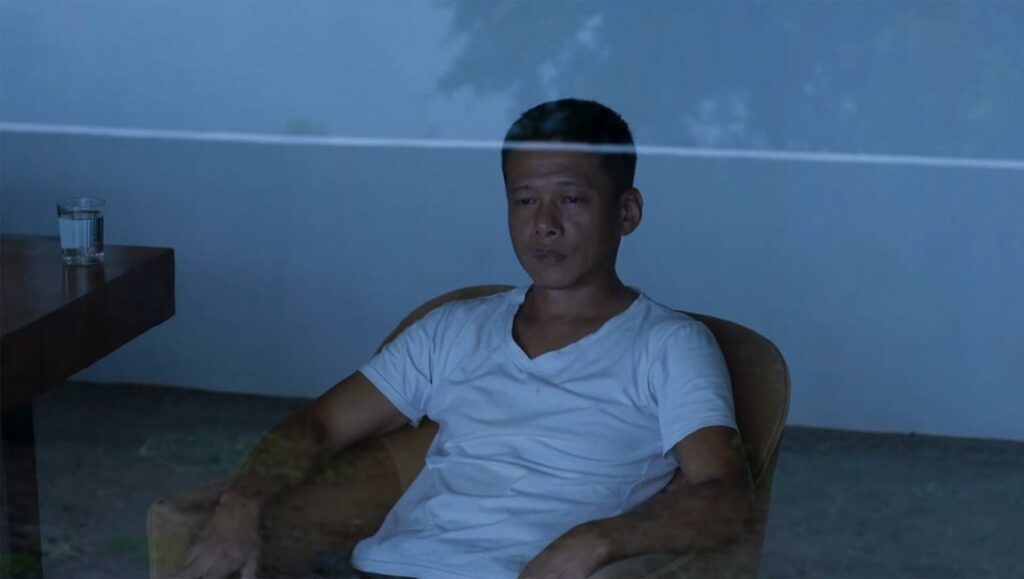#5. Premiering in competition at 2020’s Berlinale and winner of its jury Teddy Award (for LGBT cinema), Tsai Ming-liang’s Days very much continues and deepens its director’s trademark minimalism, here going so far as to renounce attempts to extrapolate a storyline over its characters. More austere than Stray Dogs, his 2013 post-apocalyptic masterpiece notorious for its final 14-min shot of a mural, and an even further cry from the auteur’s 1992 breakthrough Rebels of the Neon God, in which Tsai’s poetic sensibilities were heavily infused with punkish ennui, Days arguably constitutes the summation of Tsai’s artistic, working, and personal careers. For one, his longtime collaborator and muse Lee Kang-sheng appears in one of the only two roles. (Lee has appeared in all of Tsai’s films, feature or documentary, and was cited by the director as the “sole reason” he continues to make films.) His onscreen presence inseparable from Tsai — from a wayward student in Rebels to the disillusioned salesman in Vive L’Amour to a devastated and impoverished father in Stray Dogs — Lee ages alongside Tsai’s filmography, charting the often solitary life of a film icon through his tumultuous decades of acting, aging, and physical ailments.
And yet, something about Days strongly suggests a finality to it, more so than Tsai’s self-purported retirement after Stray Dogs (which concluded with his signature right before the end credits). Where Stray Dogs had the semblance of a narrative, even courting discussion over its supposedly elliptical presentation, Days remains firmly a faithful representation of observed reality, its formal rigor reminiscent of James Benning and Helena Wittmann. This discipline trains the viewer’s focus onto the image, distilling its ever-minute shifts, patterns, rhythms — subjects whose sheer existence has long been undermined with the advent of film, its storytelling modes, its editing (Kuleshov or otherwise), and its incapacity to be employed in service of the analytical calm that has come to shape its painterly and photographic predecessors. If it should be labeled as soporific and pointless, then so be it.
Lee’s visage, of a man now fifty, opens the film; he sits in a house by the countryside, staring at the pouring rain outside. Soon after, a younger man enters the picture but not the frame; played by Laotian newcomer Anong Houngheaungsy, the man dwells in a city apartment, gracefully engaging in tasks of mundane beauty, such as stoking a fire, washing and plucking vegetables, etc. The two men go about their separate lives, and slowly we begin to wonder how each is ever connected to the other; are they estranged relatives or ex-lovers, or complete strangers whose lives realize some semblance of harmony despite never having met? It is only an hour into the film when they are brought within the same frame. The moment is sudden: Lee has booked a hotel room in the city, where he answers a text on his cellphone, before stripping and laying face-down on the bed, following which two hands, Houngheuangsy’s, inch their way into the frame and onto his legs, caressing them in the foreplay to their massage session. The latter is very much a prostitute in this exchange, servicing — over two unbroken shots lasting nineteen minutes in total — Lee’s aging yet Adonic body, weathered over time yet oiled and erotically lustrous, before culminating in an off-screen but no less cathartic climax.
The refusal to qualify the lives of both men with plot points or cursory suggestions of their loneliness or homosexuality, doing away with the depiction of events leading up to their encounter, marks a radical departure in cinematic representation (though a pretty commonplace style of Tsai’s) in which the adage of “show, not tell” is taken to its semantic extreme. It is also a deeply humanist endeavor, relegating the political concerns that distinctly marked Stray Dogs, et al. to a backdrop and dispensing with class, language, ethnic, and age boundaries altogether in portraying the ebbs and flows of two separate narratives which, for a brief moment in the eons of banality and repetition, cross each other. Coupled with Tsai’s emphasis on corporeality, of bodies and spaces often sidelined by the ferocities of montage and incident, Days takes on a diaristic role in documenting the days and lives of men with muted yet dignified splendor.


Comments are closed.